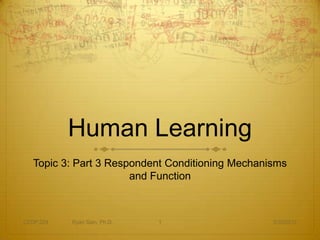324 03 part 3.1 classical conditioning mechanisms
•Download as PPTX, PDF•
0 likes•579 views
Report
Share
Report
Share

Recommended
More Related Content
More from Ryan Sain
More from Ryan Sain (20)
324 02 part 3 elicited behavior, habituation, sensitization

324 02 part 3 elicited behavior, habituation, sensitization
Recently uploaded
Recently uploaded (20)
PLAI - Acceleration Program for Generative A.I. Startups

PLAI - Acceleration Program for Generative A.I. Startups
Easier, Faster, and More Powerful – Notes Document Properties Reimagined

Easier, Faster, and More Powerful – Notes Document Properties Reimagined
Linux Foundation Edge _ Overview of FDO Software Components _ Randy at Intel.pdf

Linux Foundation Edge _ Overview of FDO Software Components _ Randy at Intel.pdf
Behind the Scenes From the Manager's Chair: Decoding the Secrets of Successfu...

Behind the Scenes From the Manager's Chair: Decoding the Secrets of Successfu...
Measures in SQL (a talk at SF Distributed Systems meetup, 2024-05-22)

Measures in SQL (a talk at SF Distributed Systems meetup, 2024-05-22)
TEST BANK For, Information Technology Project Management 9th Edition Kathy Sc...

TEST BANK For, Information Technology Project Management 9th Edition Kathy Sc...
Free and Effective: Making Flows Publicly Accessible, Yumi Ibrahimzade

Free and Effective: Making Flows Publicly Accessible, Yumi Ibrahimzade
Choosing the Right FDO Deployment Model for Your Application _ Geoffrey at In...

Choosing the Right FDO Deployment Model for Your Application _ Geoffrey at In...
Intro in Product Management - Коротко про професію продакт менеджера

Intro in Product Management - Коротко про професію продакт менеджера
Where to Learn More About FDO _ Richard at FIDO Alliance.pdf

Where to Learn More About FDO _ Richard at FIDO Alliance.pdf
Future Visions: Predictions to Guide and Time Tech Innovation, Peter Udo Diehl

Future Visions: Predictions to Guide and Time Tech Innovation, Peter Udo Diehl
AI presentation and introduction - Retrieval Augmented Generation RAG 101

AI presentation and introduction - Retrieval Augmented Generation RAG 101
324 03 part 3.1 classical conditioning mechanisms
- 1. Human Learning Topic 3: Part 3 Respondent Conditioning Mechanisms and Function CEDP 324 Ryan Sain, Ph.D. 1 3/30/2012
- 2. Contingency & Contiguity Contingency is a major key! the degree of prediction from the CS to the US effects the amount of conditioning Rescorla – p(us/cs) and p(us/no cs) Vary these probabilities using a 2 minute tone at random intervals .4 that the US would occur during a CS; .2 a US would occur during a no CS Contiguity also plays a role The shorter the ISI or TI the stronger the conditioning CEDP 324 Ryan Sain, Ph.D. 2 3/30/2012
- 3. Compound Stimuli Two or more stimuli occurring together (sound and sight - CR) then paired with a US Can test the effects of this by presenting one of the CSs alone after pairings Often you get conditioning to both But not always CEDP 324 Ryan Sain, Ph.D. 3 3/30/2012
- 4. Blocking Kamin – conditioned suppression procedure (css = light, tone, light tone; cr = shock) Two groups: blocking and control One stimulus seems to block conditioning to the other – no new predictability. Group Phase 1 Phase 2 Test Result Phase Blocking 1 Light Light/tone Tone Tone elicits no CR Control ------- Light/tone Tone Tone elicits CR CEDP 324 Ryan Sain, Ph.D. 4 3/30/2012
- 5. Overshadowing Intensity of the CS effects conditioning trials Loud CS and soft CS US = CR Test with either CS +CS = CR -CS ≠ CR But you can then use the –CS by itself and get conditioning One seems to overshadow the other CEDP 324 Ryan Sain, Ph.D. 5 3/30/2012
- 6. Experience with the CS Latent inhibition Presence of a CS in the absence of the US Delays acquisition in the future Prediction is decreased CEDP 324 Ryan Sain, Ph.D. 6 3/30/2012
- 7. Acquisition • CR is increasing in strength Strength of CR •Learn more on early trials than on later ones Number of trials CEDP 324 Ryan Sain, Ph.D. 7 3/30/2012
